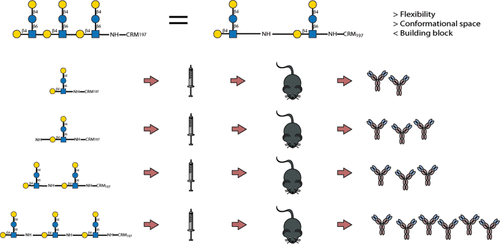当前位置:
X-MOL 学术
›
ACS Chem. Biol.
›
论文详情
Our official English website, www.x-mol.net, welcomes your
feedback! (Note: you will need to create a separate account there.)
Sequential Linkage of Carbohydrate Antigens to Mimic Capsular Polysaccharides: Toward Semisynthetic Glycoconjugate Vaccine Candidates against Streptococcus pneumoniae Serotype 14.
ACS Chemical Biology ( IF 3.5 ) Pub Date : 2020-08-24 , DOI: 10.1021/acschembio.0c00360 Bruna M S Seco 1, 2 , Fei-Fei Xu 1, 2 , Andrea Grafmüller 3 , Naresh Kottari 1 , Claney L Pereira 1 , Peter H Seeberger 1, 2
ACS Chemical Biology ( IF 3.5 ) Pub Date : 2020-08-24 , DOI: 10.1021/acschembio.0c00360 Bruna M S Seco 1, 2 , Fei-Fei Xu 1, 2 , Andrea Grafmüller 3 , Naresh Kottari 1 , Claney L Pereira 1 , Peter H Seeberger 1, 2
Affiliation

|
Vaccines based on isolated polysaccharides successfully protect humans from bacterial pathogens such as Streptococcus pneumoniae. Because polysaccharide production and isolation can be technically challenging, glycoconjugates containing synthetic antigens are an attractive alternative. Typically, the shortest possible oligosaccharide antigen is preferable as syntheses of longer structures are more difficult and time-consuming. Combining several protective epitopes or polysaccharide repeating units as blocks by bonds other than glycosidic linkages would greatly reduce the synthetic effort if the immunological response to the polysaccharide could be retained. To explore this concept, we bridged the well-understood and immunologically potent RU of S. pneumoniae serotype 14 (ST14) with an aliphatic spacer and conjugated it to the carrier protein CRM197. Mice immunized with the spacer-bridged glycan conjugates produced high levels of specific antibodies after just one or two vaccine doses, while the tetrasaccharide repeating unit alone required three doses. The antibodies recognized specifically ST14 CPS, while no significant antibody levels were raised against the spacer or unrelated CPS. Synthetic vaccines generated antibodies with opsonic activity. Mimicking polysaccharides by coupling repeating unit antigens via an aliphatic spacer may prove useful also for the development of other glycoconjugate vaccine candidates, thereby reducing the synthetic complexity while enhancing a faster immune response.
中文翻译:

碳水化合物抗原与模拟荚膜多糖的顺序连接:朝向针对肺炎链球菌血清型14的半合成糖缀合物疫苗候选人。
基于分离多糖的疫苗成功地保护了人类免受诸如肺炎链球菌等细菌病原体的侵害。因为多糖的产生和分离在技术上可能具有挑战性,所以含有合成抗原的糖缀合物是有吸引力的选择。通常,尽可能短的寡糖抗原是优选的,因为更长结构的合成更困难且耗时。如果可以保留对多糖的免疫反应,则通过糖苷键以外的其他键将几个保护性表位或多糖重复单元结合起来,将大大减少合成工作。为了探索这一概念,我们桥接了肺炎链球菌的公认且具有免疫学意义的RU具有脂族间隔基的血清型14(ST14),并将其缀合到载体蛋白CRM197。仅用一或两次疫苗剂量后,用间隔桥联聚糖缀合物免疫的小鼠就产生了高水平的特异性抗体,而仅四糖重复单元需要三剂。抗体特异性识别ST14 CPS,而针对间隔子或无关CPS的抗体水平却没有升高。合成疫苗产生具有调理活性的抗体。通过经由脂族间隔基偶联重复单元抗原来模仿多糖也可用于开发其他糖缀合物候选疫苗,从而降低合成复杂性,同时增强更快的免疫应答。
更新日期:2020-09-20
中文翻译:

碳水化合物抗原与模拟荚膜多糖的顺序连接:朝向针对肺炎链球菌血清型14的半合成糖缀合物疫苗候选人。
基于分离多糖的疫苗成功地保护了人类免受诸如肺炎链球菌等细菌病原体的侵害。因为多糖的产生和分离在技术上可能具有挑战性,所以含有合成抗原的糖缀合物是有吸引力的选择。通常,尽可能短的寡糖抗原是优选的,因为更长结构的合成更困难且耗时。如果可以保留对多糖的免疫反应,则通过糖苷键以外的其他键将几个保护性表位或多糖重复单元结合起来,将大大减少合成工作。为了探索这一概念,我们桥接了肺炎链球菌的公认且具有免疫学意义的RU具有脂族间隔基的血清型14(ST14),并将其缀合到载体蛋白CRM197。仅用一或两次疫苗剂量后,用间隔桥联聚糖缀合物免疫的小鼠就产生了高水平的特异性抗体,而仅四糖重复单元需要三剂。抗体特异性识别ST14 CPS,而针对间隔子或无关CPS的抗体水平却没有升高。合成疫苗产生具有调理活性的抗体。通过经由脂族间隔基偶联重复单元抗原来模仿多糖也可用于开发其他糖缀合物候选疫苗,从而降低合成复杂性,同时增强更快的免疫应答。











































 京公网安备 11010802027423号
京公网安备 11010802027423号